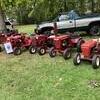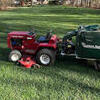-
Similar Content
-
 By Swemill
By Swemill
Hi everyone!
Long time since i was here and my old pics is gone from the forum.
I just uploaded a movie with pics on youtube, and thought i could share it for you guys.
I would love to get some comments on my Youtube channel, from you true Wheel Horse fans!
Thanks and Best Regards
-
 By 87buickt
By 87buickt
Listing for a friend, late 70s I believe D200 deck and plow. Been sitting for a while, make reasonable offer, friend also has tons of literature he may part with, if Interested let me know
-

-
 By wh315-8
By wh315-8
Anyone be able to measure out the Top Link Bar for the 50” D Series Tiller?
Just finished rebuilding a tiller, have a adjustable type but would like to put a original type on like the manual has listed.
-
 By BMW1
By BMW1
What gauges were standard on wheel horse D160 D180 D200 series tractors?
Was the dash light only an option on the D200?
On D180 and D200 series tractors I've seen, it seems like they all had Ammeter, oil pressure, and transmission temperature.
I've only seen engine hours and dashlight on one D200.
I'm not sure about D160. I have never seen one up close.
Thanks.
-

